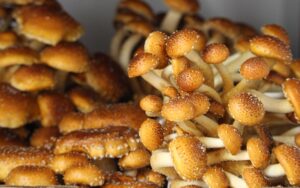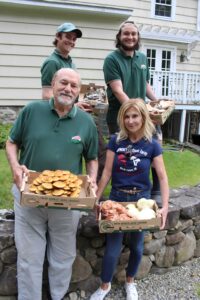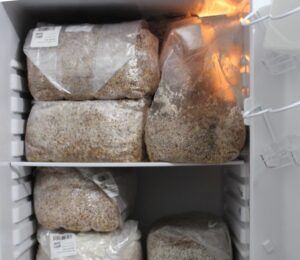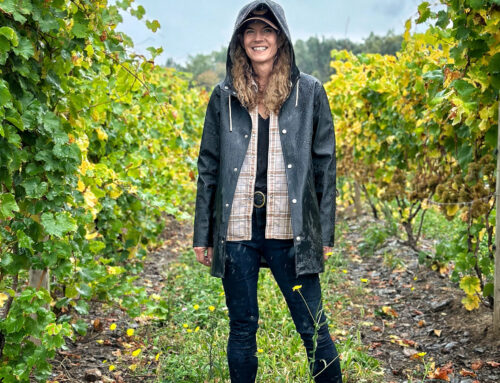Writing by Ava Fleisher
Photography by Annalia Pantaleon
It was the middle of nowhere in rural Massachusetts. Richard Stewart turned into the driveway of a little house and parked next to a pile of tires and broken-down cars. As his eyes met the front door, a man with a distinct 1960s vibe walked out. Stewart, who had just finished gutting his basement, was there to pick up three autoclaves (devices typically used to sterilize mushroom substrates, among other things) he’d purchased on Craigslist.
“He sold me three of those autoclave units, 1,000 bags for mushrooms and some clambake-style propane burners that we still don’t know what to do with,” Stewart, the owner and manager of Stewart-Watson Farm, remembers.
At the time, Stewart had recently switched careers because he felt “unfulfilled” with his work in corporate law.
“I was a lawyer for 50 years in New Canaan, Connecticut, wanting to get out of the law,” he explains “I couldn’t sit around, so I went on YouTube and saw a video that said that you can learn how to grow mushrooms in your basement.”
Stewart was in. He gutted his basement to make room for his new mushroom-growing endeavor.
Fast forward a few years, instead of working 50 hours a week and making $500/hour as a lawyer, he’s working upwards of three times the amount of hours and losing $500 weekly.
While working to develop the farm, instead of working 50 hours a week and earning $450/hour as a lawyer, Stewart was working the same number of hours a week, but losing $500 a week, too.
Enter Arthur “Kitt” Watson who was working in the private equity and venture capital world, loved science as a kid and discovered a passion for gardening at the beginning of the pandemic. When Watson’s mom, Rebecca, Stewart’s fiancé, suggested that Watson take a look at Stewart’s mushrooms, he obliged.
“The interest blossomed into a passion,” says Watson. “So here I am, two and half years later.”
Shortly after he joined, they realized they could expand and acquire clients in the area. Stewart’s family background in the supermarket industry gave them a leg up, allowing them to start by selling their mushrooms to one local market and one restaurant (Walter Stewart’s market– Stewart’s family market– and 121 Restaurant, respectively).
“So right off the bat, we kind of had ins at two places, so we could learn the ins and outs of how to do that the best way,” Watson remembers.
Watson became the operating partner and mycologist (he’s quick to point out he’s self-taught), and transformed the one-man basement operation into a successful, functioning business. Now, with the help of Mason Kelsey, who serves as the head of production, Stewart-Watson has 18 clients, including restaurants and food markets, spanning from Irvington to Westport (they say they’d be happy to find clients even further north and south, if anyone knows of leads). Today the farm has began to break even and make a profit.
They’ve also expanded from growing four to 12 varieties of mushrooms: Black King Trumpet, Blue Oyster, White Oyster, Phoenix Oyster, Chestnut, Golden Oyster, King Trumpet Oyster, Lion’s Mane, Pink Oyster, Maitake, Shiitake and Snow Oyster.

Bumps in the Road
Growing these mushrooms, particularly in the first stages of the process, hasn’t always been easy though. In fact, it took them at least six months to perfect their growing method, and Watson says it’s always a work in progress.
“In the last six to eight months we really got our process dialed in,” Watson notes.
Once the bags of mushrooms are ready to be taken to the fruiting chamber, where they can sprout, it’s just a matter of patience.
“This is really where I’ve benefited the most, just from the observation,” says Watson. “There’s a timeline that most growers work with. If you’re able to have a bag colonized and ready to fruit within ten days to two weeks, you’re in good shape.”
However, that’s not always the case; colonizing (when the mycelium, similar to the roots in a mushroom, grow through the substrate bags) timelines vary greatly depending on the type of mushroom. A Blue Oyster, for example, takes about 14 days, whereas King Trumpets can take up to four weeks. To help better project these specific timelines, Kelsey is working on data collection to hopefully make the process run just a bit smoother.
As for the equipment itself, they’ve also had to make do with what they have, and sometimes, get a little creative. Take their make-shift super pasteurization system, for example. They bought a barrel hoping it could function as a sterilized pressure system – a key piece of equipment in the mushroom growing process because it rids the substrate of any harmful pathogens before it’s left to sprout mushrooms. But, things didn’t quite go as planned.
“The cap doesn’t fit,” Watson explains. “We’ve spoken to a lot of different distributors, and they said there was a gigantic batch that came from China where the barrels just didn’t fit the caps quite well enough. No other top we order will fit it.”
So instead of it being a pressurization system, they turned it into a pasteurization system, which is ultimately the same, except that the pasteurization cooks the substrate longer than a pressurized system. And even then, there’s no guarantee that all the bags will turn out right.
“Sometimes the bags expand a little too quickly,” says Watson.
That means that while there should be 42 bags in a batch, sometimes, there are a few less.
Watson says it best: “Most functioning farms have an element of duct tape and chicken wire, and that’s just how it is.”

Mushrooms and humans: A symbiotic relationship
“Mushrooms are just like us,” says Watson. “They breathe in oxygen and exhale carbon dioxide.”
So to keep the mushrooms growing, the team has installed a variety of equipment to remove the carbon dioxide and bring oxygen in.
Watson says he’s developed somewhat of a personal relationship with mushrooms. He talks to them (greeting them every morning by saying, “Hello, my beauties. How are we doing today?”) and gives them little pep talks, but he says he draws the line at giving them names because that would just be too heartbreaking if they didn’t make it.
“Having the ability to see something we’ve grown with our own hands is so fulfilling,” Watson reflects. “We grew these with our blood, sweat and tears, and I’m very proud of the operation and what we’re able to make.”
The mushrooms also hold a special place in Stewart’s heart.
“I think about the difference of doors,” he says. “I used to open doors to the courtroom and there would be some gnarly people, like judges or lawyers, who didn’t have the right thing for breakfast. But now, when it’s my turn to deliver [the mushrooms], when I open a door, it’s to a kitchen with kids and when they see the mushrooms, everybody smiles. There’s no gnarly faces anymore.”
Looking ahead
Stewart-Watson has a few short-term goals: find “less labor-intensive and more economic ways of growing”, increase their customer base, and offer new forms of their pre-existing product including powders and spawn blocks to grow mushrooms at home.
The first goal is slowly being accomplished via an experiment in a smaller fruiting chamber where one can find mushrooms growing on straw or sawdust, as well as through Kelsey’s data collection. They’d also like to find a way to use other growing methods that include a simple log in the woods, which would allow the mushrooms to grow in a slightly less controlled environment.
Looking even further ahead, Watson says he’d one day like to open a second or satellite location that has just one building that can get the job done. Today, it’s spread across several rooms in the basement and two separate buildings that serve as the fruiting chambers.
“We’re definitely still trying to figure out how to optimize things in a finite amount of space, but we’re also banging out the most for the area we have,” he says.
Rebecca Watson would like to expand the farm to the public more, integrating tours into their schedule, including those to school-aged kids, which they’ve already began to schedule.
All things considered, the entire Stewart-Watson team takes immense pride in the business they’ve built that started merely from a Youtube video and some corporate burnout. To them, having something tangible to show for all their hard work is a spectacular feeling.
This article was published in the July/August 2023 print edition of Katonah Connect.
Growing mushrooms: A step-by-step process
Mushroom inoculation
Growing mushrooms is simple. All it takes is several pieces of very specific equipment, a perfectly-timed schedule, precise conditions, regular observation and a lot of patience. Okay, maybe it’s not so simple after all.
The first steps in their “jerry-rigged” mushroom process take place in the basement of Stewart’s house, a.k.a. Stewart-Watson Farm’s headquarters, throughout a series of low-ceilinged rooms, each featuring a different and highly distinctive smell.
The process begins with a very large bag of soy and oak fast-fruiting mushroom pellets that Watson or Kelsey installs on an air-powered auto bagging system – or an “auto bagger hopper” as Watson calls it. It pours precisely one pound 14 ounces of substrate into about 40 new, smaller bags, one after the other.
Next, they add about three and a half liters of water into each new bag, and once the water is absorbed, the bags are folded into bricks.
Step three is to place the bricks into a pressure sterilization unit that cooks the brick for about five hours at 212 degrees with 15 -17 pounds of pressure. This is key to successfully harvesting mushrooms.
“You now have super-sterilized bags, which is your best chance at succeeding against those microbes [that can compromise the process],” says Watson.
Approximately 17 hours later, the sterilized bags are placed onto shelves in a back room where they are labeled with the mushroom type and important dates. Then they’re brought to a special area where they’re injected with spawn, which, according to Watson, is similar to seeds.
“Mason or I will take the bag, put it on a scale, and have a flow hood run the whole time so that it receives sterilized air,” Watson explains. “We put on masks and gloves and then tear the bags to distribute about four to five ounces of spawn into each bag.”.
They give the bags one last blast of fresh air before sealing them with heat.

Autoclaves used in the sterilization process.

Assorted mushroom spawn, bagged and ready to inoculate sterilized/pasteurized substrate.
Growing mushrooms
With inoculation complete, they bring the bags into a third room where the folks at Stewart-Watson Farm simply watch and wait for the bricks to sprout mushrooms.
When ready, they move the bags to the “fruiting chamber,” across the way where they will blossom into beautiful and regenerative mushrooms. This means that once the mushrooms grow an acceptable amount, they can be cut and will regrow.
This room must stay between 60 and 65 degrees Fahrenheit, with the humidity between 88 and 90 percent, with the help of some very nifty temperature-regulating equipment.
And with the exact right conditions, it takes the bricks about seven days (depending on the variety) to fully grow into mushrooms that can be harvested for market. Each regenerative brick can be used two or three times before it will no longer produce mushrooms.
In the meantime, Watson and Kelsey are already sterilizing new bags of mushroom pellets, inoculating them and beginning the sprouting process so that they can meet their current orders of 225 pounds of mushrooms a week.

Ava Fleisher
Ava Fleisher is Connect To's star intern and a local high school student. When she’s not writing, you can find her spending time outdoors, reading, or volunteering in her community. When she grows up, she would like to pursue a career in journalism and travel the world.










